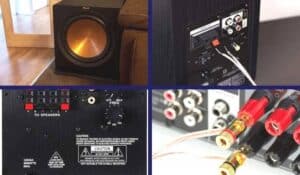Subwoofers are intended primarily to enhance your sound system’s audio quality. They anticipate and recreate the low-frequency sound and enable you to enjoy incredible audio from your home theatre. In comparison with most speakers, audio may be improved considerably more by subwoofers. You will need audio or even a video receiver and a few speakers to add the woofer to the home theater. A very important component is the proper connection of the subwoofer to the receiver system.
This article describes how to link a subwoofer through a SUB OUT or LFE output from a receiver or amplifier to a receiver or amplifier or by RCA or speaker wire hookups from a subwoofer. The steps and guidelines are well stated to help you follow step by step to achieve a quality sound.
Other than the methods, this article also contains some general knowledge on the subwoofer connection. In case you need extended knowledge on this connection, there are answers to the frequently asked questions. So follow the steps and methods keenly to get every basic knowledge of the subwoofer connection.
Table of Contents
Methods of connecting a subwoofer without subwoofer output to a receiver

1. Set the speakers on the “left” or “right.”
Learn about managing your AV recipient bass first of all. To accomplish this, configure all the center, rear, and main speakers (both left and front) of the big group or the small group depending on their output capacities. Then, follow the guidelines of the manufacturer to learn more about bass management methods.
However, every set of speakers, from tiny to big, is usually suggested. To get the greatest output, position all your speakers equally and use an 80 Hz crossover. When you put your front and left speakers in smaller positions, the subwoofers perform well. Even with two-channel sounds, this is effective. However, when the primary speakers are tuned to the big pattern, things are likely to be rather difficult.
2. Put the “Main + LFE” on your satellite
This technique is successful when you place the speakers on your left and right. Next, search your receiver for the subwoofer setting. The ‘pass-out’ function of your AC recipient helps you to understand when and how your subwoofer is operating. Then configure the ‘mains + LFE’ so that your subwoofer may play when the headboards are set to big.
There are also several bass management receivers for two channels. They provide you with separate crossover settings, slow-up and down levels, etc. You may also select whether or not you require the subwoofer to activate two-channel audio sources.
3. Use the output preamp
You can still link a subwoofer to the subwoofer if your receiver has no subwoofer output. First, check on the back panel of your receiver to check whether the preamp output is available or not. Usually, it is labeled as ‘pre-out.’
When the pre-out is found, utilize a few interconnections between the receiver and your subwoofer. For example, if you have just one RCA input, connect a Y adapter to your subwoofer with one male RCA only on closing and two female RCAs from the other closing.

4. Use speaker cables to plug the subwoofer into the recipient
Again, your receiver has no preamp output; you may utilize your subwoofer as a speaker. To connect your subwoofer to the receiver, run speaker cables. Connect it to the receiver’s front right and the left speaker connections. Then connect the left and right headers to the subwoofer’s speaker connector. The subwoofers on the market usually come with speaker capabilities. Still, before you buy yours, you should check.
A subwoofer may change the sounds of the low note that speakers cannot. You may feel the music like an atmosphere in your chest. Connect the woofer to your home theater system and enjoy an amazing quality sound. Follow the steps here to connect your receiver to the subwoofer with no sub-out system.
Frequently asked questions
1. How can one connect the output of the LFE Subwoofer?
The recommended way to connect a subwoofer is through an LFE cable (an acronym for Low-Frequency Effects) from the subwoofer output (designated as ‘SUB OUT’ or ‘SUBWOOFER’). Almost every home theater (or processor) receiver and some audio receiver has that kind of subwoofer output. LFE ports are a specific output for subwoofers exclusively; they are still marked as ‘SUBWOOFER’ but not as LFE.
5.1 Channel audio, for example, DVD or TV media, includes a channel output with the channel’s bass content that a subwoofer reproduces well. To set this up, connect the LFE or the subwoofer output jack to the ‘Line In’ or ‘LFE In’ Jack to the subwoofer at the receiver/amplifier. Normally, there is only one cable having single RCA connections at each end.
2. How can one Connect Stereo RCA or voice level outputs?
Sometimes you discover that the LFE woofer output of receivers or amplifier is not available. Or the subwoofer might not be having the LFE input. Rather, the subwoofer may include RCA stereo connections on the right and left, that is, the R and L. Or they might be springy clips like you would find at the rear of conventional speakers.
If the “Line In” of the subwoofer utilizes RCA cords, then connect into the subwoofer with an RCA cable. If the cable splits on one end, for example, a y-cable for both left and right channels, connect both R and L ports to the subwoofer. If you also have RCA connectors left and right for woofer output, you must also plug them into the receiver.
If the subwoofer has spring clips, you may utilize the speaker output from the receiver to connect them all up. This is the way a simple stereo speaker is connected. Keep the channels in mind. If the woofer has two pairs of spring clips that are for the speaker out and the speaker in, then additional speakers connect to the woofer, which connects to the receiver so that an audio signal passes along.
If the subwoofer only has one pair of spring clips, the subwoofer must share the same receptor connections as the speaker. The easiest method to do this is to use banana clips (against overlapping naked wire) that can connect to each other’s back.
Conclusion
In conclusion, Subwoofers are generally simple to attach since just two cables are available: one used for power while the other one for audio. You are far more likely than to plug a pair of wires to spend most of your time placing and modifying a subwoofer for optimum efficiency. To always get the best output, you should always set your speakers equally. To connect the subwoofer to the receiver, you should plug in your woofer to the sub out of the receiver. The model of the subwoofers varies from one to the other.
It is always advisable to handle these connections with maximum care each time you making the connections. If you cannot connect your subwoofer after following the above steps, you can refer to your manual. If it does not respond still, seek help from a specialist. In circumstances where you are not so sure on what to do, always contact a professional or an expert. Seeking help from an expert will save you time and also prevents other damages.
